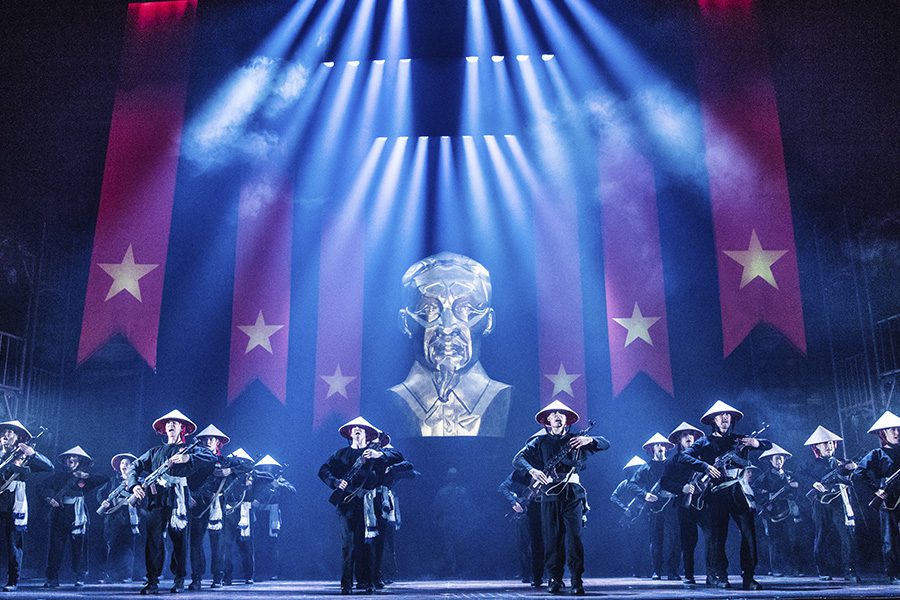Director: ‘Miss Saigon’ Still Contemporary
By • January 10, 2019 0 875

When it comes to Broadway musicals, we seem to be living in the age and afterglow of the acclaimed, totally hot-ticket, spectacular and hip “Hamilton,” or, cerebrally and with-it, the Tony-honored “Dear Evan Hansen” — which is, in comparison, almost a musical chamber piece and cool to the touch, with teen suicide as its subject.
We forget sometimes that there used to be a time — call it the age of Andrew Lloyd Webber and Cameron Mackintosh — when the West End in London, Broadway and stages all over the world, including the Kennedy Center and the National Theatre, were teeming with big, spectacular, crowd-pleasing musicals that aimed not just to please but to bowl audiences over with sight, sound and set pieces, narratives playing out in memorable songs and overwhelming stagecraft.
From the fertile minds and ambitions of Webber, often with lyricist Tim Rice, and producer Mackintosh came “Evita,” “Jesus Christ Superstar,” “Cats” and “The Phantom of the Opera.” Likewise, Claude-Michel Schönberg and Alain Boublil gave us “Les MIserables” and “Miss Saigon.” These and others splashed down to long runs and big audiences, launching long-running road tours and new versions.
The shows were memorable. They featured music that was rock-and-rollish, over the top, replete with anthems and ballads that had the ability to stay in the mind whether you liked it or not.
Some critics — especially in America — were underwhelmed, bemoaning what looked like a European takeover of a form once dominated by Rodgers and Hammerstein, Lerner and Lowe, Porter, Gershwin and other creators of Great American Songbook musicals. They were not impressed by a staple of the big musicals, spectacular sets and stagecraft tactics that sought to actually escape the stage and wow you with the effects: the barricades of “Les Mis,” the downward spiral toward the audience of the chandelier in “Phantom,” the life-size helicopter carrying Americans out of Saigon in “Miss Saigon.”
Actually, while other shows came and went over the years, these mighty productions never really left; new and newer versions of them continued to appear. Most of them involved, at one level or another, director Laurence Connor, who knows a few things about the further evolutions of shows that often became films as well (not to mention the big shows on the way).
We can see examples of that now in shutdown city, Washington, D.C. Proof positive of the continued popularity of the genre is the current production of “Miss Saigon,” directed by Connor. It launched in England, went to Broadway for a limited run and, as part of the revival’s national tour, is winding down its Kennedy Center engagement at the Opera House through Jan. 13.
Connor, who worked on and directed the first tour of “Miss Saigon,” is also directing the new version of Andrew Lloyd Webber’s “School of Rock,” which will be at the National Theatre from Jan. 16 to 27.
You would think he’d have some doubts that “Miss Saigon,” with its “Madame Butterfly” story and Vietnam era setting, might still be relevant. “Miss Saigon” debuted in Drury Lane in London in 1989 and opened on Broadway in 1991, still not all that distant from memories of America’s difficult and costly war in Asia. But it’s now 2019, and new generations of theatergoers would appear to have a less of an avid interest in a tragic story of a Vietnamese woman left behind by her American lover.
“That’s not the case,” Connor said. “I think it’s very contemporary. I think its themes, its plot and its presentation will resonate with contemporary audiences. It has all of its special qualities of the music, the drama and a certain freshness. It has integrity, I think.
“I think sometimes people overemphasize the big moments — like the helicopter, or the barricade, the chandelier,” he continued. “But it’s not the reason people are affected. It is, as always, the music and the story, especially the story, the narrative. It’s not a history piece removed in time. It depends, like many of these projects, a good deal on stagecraft. They’re difficult to do. They require a tremendous amount of cooperative effort to pull off. And that’s where what I do comes in. Direction is pulling together, having a vision, but getting it to work properly.
“On a tour, for ‘Miss Saigon’ and the others, there are other considerations, of course — language, the size of the stage, how much you can do and how you do it. But it’s always the story. The music has to connect to the audience, the characters have to move an audience. That’s why the shows work, no matter what the subject is.
As late as 1990, a young Connor was a dance captain on one of the production of “Les Miserables,” but he also directed the children who performed in the show. From there, the leap to the creative, production side, as opposed to performing side, of the big shows came naturally.
He has said that the most difficult and most important thing a director must do is to honor the original production.
The shows have become a kind of staple worldwide, rivaled perhaps only by the continued appeal and draw of “Wicked” or “The Lion King” on the Disney front. Given the passage of time, the overall effect is a kind of natural durability. Connections are made all over the world, and always to the story. Connor remembers in his travels people coming up to him and recalling seeing one of the touring productions he directed.
Time is something that changes, adds to and alters plays, makes them enduring or not. The controversy that surrounded casting a non-Asian in the part of the Engineer, a Saigon fixer figure, early in the first production of “Miss Saigon” has long since been resolved. But in a turmoil-filled, dangerous world of ongoing conflicts, “Miss Saigon” still resonates.

